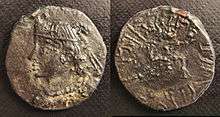Paratarajas

Obv: Robed bust of Bhimarjuna left, wearing tiara-shaped diadem.
Rev: Swastika with Kharoshthi legend surrounding: Yolatakhmaputrasa Parataraja Bhimarjunasa ("Of the Parataraja Bhimarjuna, son of Yolatakhma"). From Loralai Pakistan.
1.70g. Senior (Indo-Scythian) 286.1 (Bhimajhuna), since corrected to Bhimarjuna by H. Falk [1]
The Pāratarajas were a dynasty of kings who ruled an area that is now in the Pakistani province of Baluchistan, from the 1st century to the 3rd century CE.
The dynasty of the Pāratas is thought to be identical with the Pārthava of Iranian literature, the Parthians of Greek literature, and the Pāradas of Indian literature.[2]
Numismatics
The Pāratas, an Iranian people and ruling dynasty from what is now western Pakistan, are known essentially through their coinage, which typically exhibit the bust of a particular monarch on the obverse (having long hair within a headband), and a swastika within a circular legend on the reverse in Kharoshthi (usually copper coins) and sometimes in Brahmi (usually silver coins). Coins depicting Pārata monarchs have been found in and around the district of Loralai, Balochistan, western Pakistan. This may have been their capital.
Classical and historical sources
In about 440 BCE, the Greek historian Herodotus described the Paraitakenoi as a tribe ruled by Deiokes, an Iranian monarch who ruled on eastern-most region of the Iranian plateau. (History I.101).
Arrian described how Alexander the Great encountered the Pareitakai in Bactria and Sogdiana, and had Craterus conquer them (Anabasis Alexandrou IV).
The Periplus of the Erythraean Sea (1st century CE) describes the territory of the Paradon beyond the Ommanitic region, on the coast of Balochistan.[3]
Rulers
The Paratarajas rulers were as follows:[4]
- Yolamira, son of Bagareva (c. 125–150 CE)
- Bagamira, son of Yolamira (c. 150 CE)
- Arjuna, a second son of Yolamira (c. 150–160 CE)
- Hvaramira, a third son of Yolamira (c. 160–175 CE)
- Mirahvara, son of Hvaramira (c. 175–185 CE)
- Miratakhma, another son of Hvaramira (c. 185–200 CE)
- Kozana, son of Bagavharna (and perhaps grandson of Bagamira?) (c. 200–220 CE)
- Bhimarjuna, son of Yolatakhma (and perhaps grandson of Arjuna?) (c. 220–235 CE)
- Koziya, son of Kozana (c. 235–265 CE)
- Datarvharna, son of Datayola I (and perhaps grandson of Bhimarjuna?) (c. 265–280 CE)
- Datayola II, son of Datarvharna (c. 280–300 CE)
References
- ↑ Falk, H. "The names of the Paratarajas issuing coins with Kharosthi legends", Numismatic Chronicle, 2007: 171-178.
- ↑ "New light on the Paratarajas" p11
- ↑ "New light on the Paratarajas" p29-30
- ↑ Further Light on the Paratarajas
- Tandon, P. "New light on the Paratarajas", Numismatic Chronicle, 2006. Pdf
- Falk, H. "The names of the Paratarajas issuing coins with Kharosthi legends", Numismatic Chronicle, 2007: 171-178.
- Tandon, P. "Further light on the Paratarajas", Numismatic Chronicle, 2009. Pdf